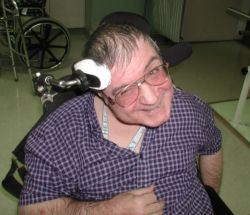Designers: Diana Hsu, Elizabeth Strautin
Client Coordinators: Mark Pennington, Claudius Parker, Cassandra Rooke
Supervising Professor: Dr. Larry N. Bohs
 Our client has quadriplegia from a car accident 20 years ago. As a result of his injuries and gradual weakening of his neck muscles, his head leans to the right side of his body. This unnatural position of his head has caused much upper back and neck pain. We devised a supporting headpiece that raises our client’s head to an upright position. The headpiece, which attaches to the client’s wheelchair, supports his forehead and provides a wide range of adjustment, so his therapists can move his head to an upright position at a comfortable pace. The device reduces the pain in his upper back and neck, and also allows him to make eye contact when communicating with others.
Our client has quadriplegia from a car accident 20 years ago. As a result of his injuries and gradual weakening of his neck muscles, his head leans to the right side of his body. This unnatural position of his head has caused much upper back and neck pain. We devised a supporting headpiece that raises our client’s head to an upright position. The headpiece, which attaches to the client’s wheelchair, supports his forehead and provides a wide range of adjustment, so his therapists can move his head to an upright position at a comfortable pace. The device reduces the pain in his upper back and neck, and also allows him to make eye contact when communicating with others.
How this project helped
The client said, “After 22 years of not having a brace of any kind, my neck had gotten adjusted to not having one, but my back and shoulders hurt a lot from the pressure of my head leaning severely to one side. Many thanks for such a good brace. Everyday I use it more and more. It has really improved my life. I can breathe better and my back does not hurt like it used to.” His case manager, Mark Pennington, added “The device continues to serve him well and he is able to operate it on his own even with his limited mobility. Many of his co-workers have commented about how much better he looks with his head in a more upright position instead of falling over to the side.”
In designing the head and neck support, we regularly met with our team of supervisors, two occupational therapists and our client’s supervisor at his work, to discuss the development of the design and to define the needs of our client. Based on initial meetings, we determined that the side of our client’s head needed to be supported. This side support would be used in conjunction with an occipital support, which would be attached and adjusted separately. The initial design gave support along the right side of our client’s head and extended under his chin, and allowed him to adjust and move the support himself. This design was not fully approved by our supervisors because of two concerns. The first concern was that the design of the side headrest might injure him by putting too much pressure on his jaw. The second concern was that our supervisors wanted to monitor and regulate most movement of the headrest, rather than allowing the client to move it independently. In this way, they would determine the change in angle of his head over a period of time. However, they believed that allowing him to move the device into and out of position would be an important feature, so that he could remove it when necessary for comfort. These additional constraints were incorporated into the final design, which connected a Pro-L9S support (Whitmyer Biomechanix, Inc.) to the client’s wheelchair through a grouping of lock collars seen in Figure 2. The Pro-L9S allowed fine positioning adjustments to be made by the therapists, but also for the client to move the headrest in and out of position using a sliding sleeve. A foam-padding sleeve cover was added to make it easier for him to grasp and slide the sleeve. The rod connected to the ball end of the Pro-L9S was not long enough to reach our client’s head, so an extension tube was added, lengthening the rod by 4″. We also altered the angle of the ball end of the Pro-L9S so that the headrest would rest in the correct direction and the side arm would fold in the correct direction when not in use. After testing various headrest shapes and padding, a small headrest that would not interfere with our client’s glasses and a Sunmate 1 open celled foam were chosen. Covers for the headrest were designed from socks for easy removal and cleaning. The Whitmyer Biomechanix Pro-1 head support system was purchased to provide occipital support when the side arm was being used. The cost of parts and materials was about $650.